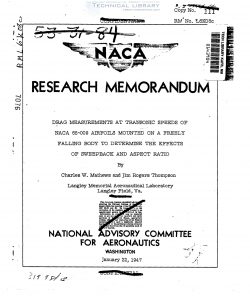naca-rm-l6k08c
- Version
- 226 Downloads
- 694.84 KB File Size
- 1 File Count
- March 14, 2017 Create Date
- March 14, 2017 Last Updated
National Advisory Committee for Aeronautics, Research Memorandum - Drag Measurements at Transonic Speeds of NACA 65-009 Airfoils Mounted on a Freely Falling Body to Determine the Effects of Sweep back and Aspect Ratio

Drag measurements at transonic speeds on rectangular
airfoils and on airfoils swept back 45° are reported.
These airfoils,which were mounted on cylindrical test
bodies,are part of a series being tested in free drops
from high altitude to determine the effect of variation
of basic airfoil parameters on airfoil drag characteristics
at transfinic speeds. These rectangular and swept-back
airfoils had the same span, airfoil section (NACA 65-009),
and chord perpendicular to the leading edge. The tests
were made to compare the drag of rectangular and swept-
back airfoils at a higher aspect ratio than had been used
in a similar comparison reported previously.
The results showed that the drag of the swept—back
airfoil was less than 0.15 that of the rectangular airfoil
at a Mach number of 1.00 and less than 0.50 that of the
rectangular airfoil at a Mach number of 1.17.
A comparison of these swept—back airfoils with
similar airfoils of lower aspect ratio previously tested
by the same method indicated that in the investigated
speed range reduction in aspect ratio results in increased
drag. In the highest part of the investigated speed range,
however, the drag coefficient of the high~a3pect—ratio
swept-back airfoils showed a tendency to approach that of
the lower—aspect-ratio swept—back airfoils. A similar
oomph ison for the rectangular airfoils showed
that delay in the drag rise and a reduction in drag at f
supercri.tical speeds can be realized through reduction a
in sepect ratio.
A serious limitation on practical flight in the
transcnic-speed range results from the large abrupt
increases in drag of conventional_airplane_configurations
as schic Speed is approached. Because of the imporu
tance of this problem, a series of tests is being conducted
at the Lansley Memorial Aeronautical Laboratory of the
NASA to determine aerodynamic shapes and cenfigurationsv,
that have a minimum of drag at transcnic speeds. In these
tests, data are telemetered from special test configurations
during free fall from high altitude. Previous tests in
which this method was employed were reported in references 1
and 2.
The object of the present tests was to compare
the drag of rectangular and swept-back airfoils at a higher
aspect ratio than had been used.in a similar comparison
reported in reference 2,For the tests reported herein drag
measurements were made on rectangular airfoils and on airfoils having
45° sweepback. These airfoils insorncrated NACA 65-009
sections of equal chord perpendicular to the leading edge
and differed from the airfoils of'reference"2 only by an
increase in even. The subscript 1 has heed deleted from
the designation of NACA-S—series airfoils with thickness
ratios less than 0.12 of the chord." The airfoil designated
65-009'in the present paper, therefore, is the airfoil
section designated 651-009 in reference 2.
| File | Action |
|---|---|
| naca-rm-l6k08c Drag Measurements at Transonic Speeds of NACA 65-009 Airfoils Mounted on a Freely Falling Body to Determine the Effects of Sweep back and Aspect Ratio.pdf | Download |

Comment On This Post